Analysis of Leadership Styles at Flight Centre Travel Group
VerifiedAdded on 2021/02/19
|9
|2494
|73
Report
AI Summary
This report analyzes the leadership styles and techniques employed by Flight Centre Travel Group (FTL), a major Australian travel agency. It begins with an introduction to FTL's structure, its staff-focused and client-focused approach, and the significance of effective leadership. The main body delves into the democratic and servant leadership styles currently used, discussing their positive and negative aspects. It then explores specific leadership techniques implemented by FTL, such as 'de-hassle instead of delegating' and 'praise fast,' while also identifying potential drawbacks. The report then proposes a shift towards persuasive leadership, outlining its advantages and disadvantages, and suggests techniques like answering questions with questions. To implement these changes, the report recommends the Kotter's eight-step change model. The conclusion emphasizes the importance of adapting leadership styles to achieve organizational goals and enhance productivity. The report references various books and journals to support its analysis.
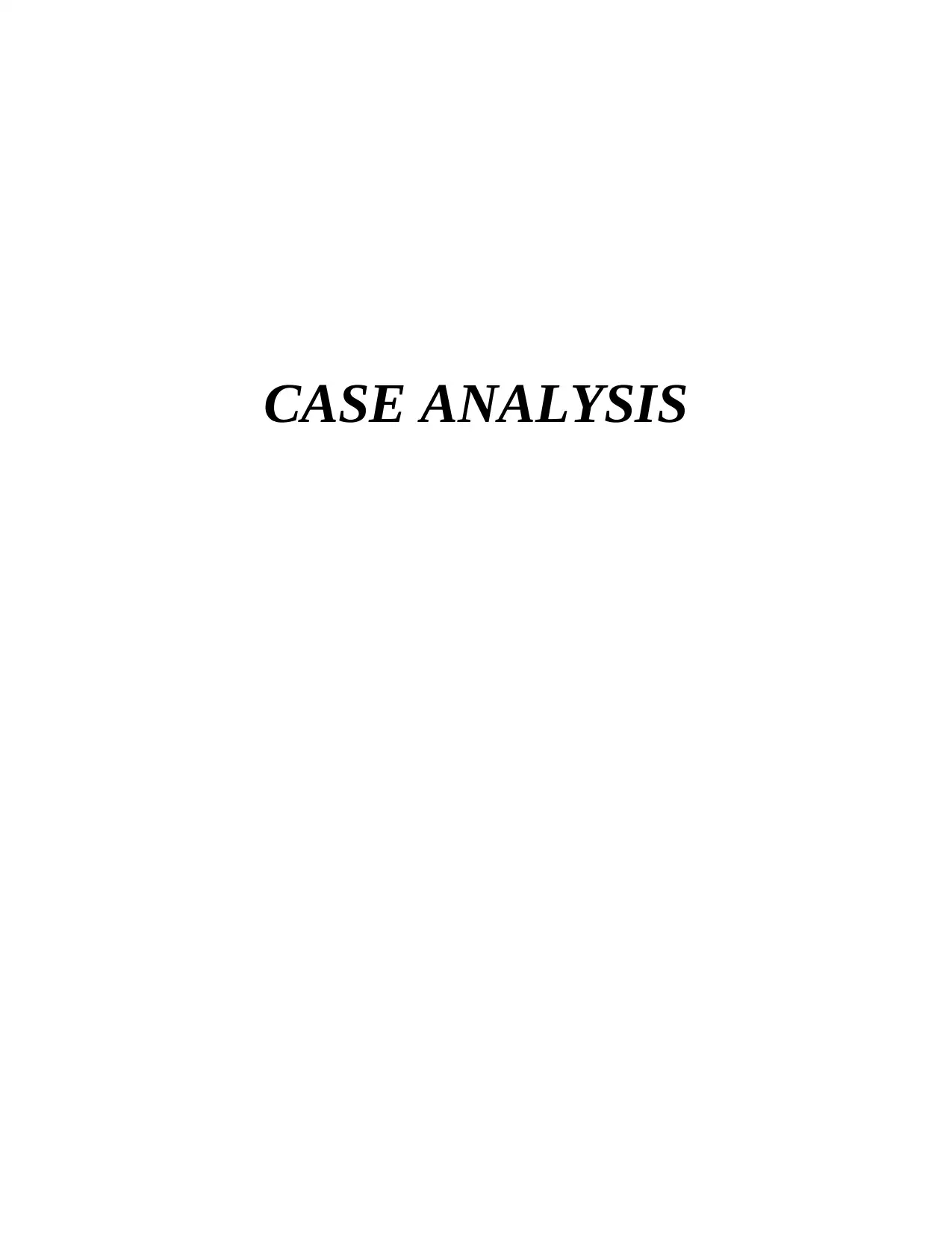
CASE ANALYSIS
Paraphrase This Document
Need a fresh take? Get an instant paraphrase of this document with our AI Paraphraser
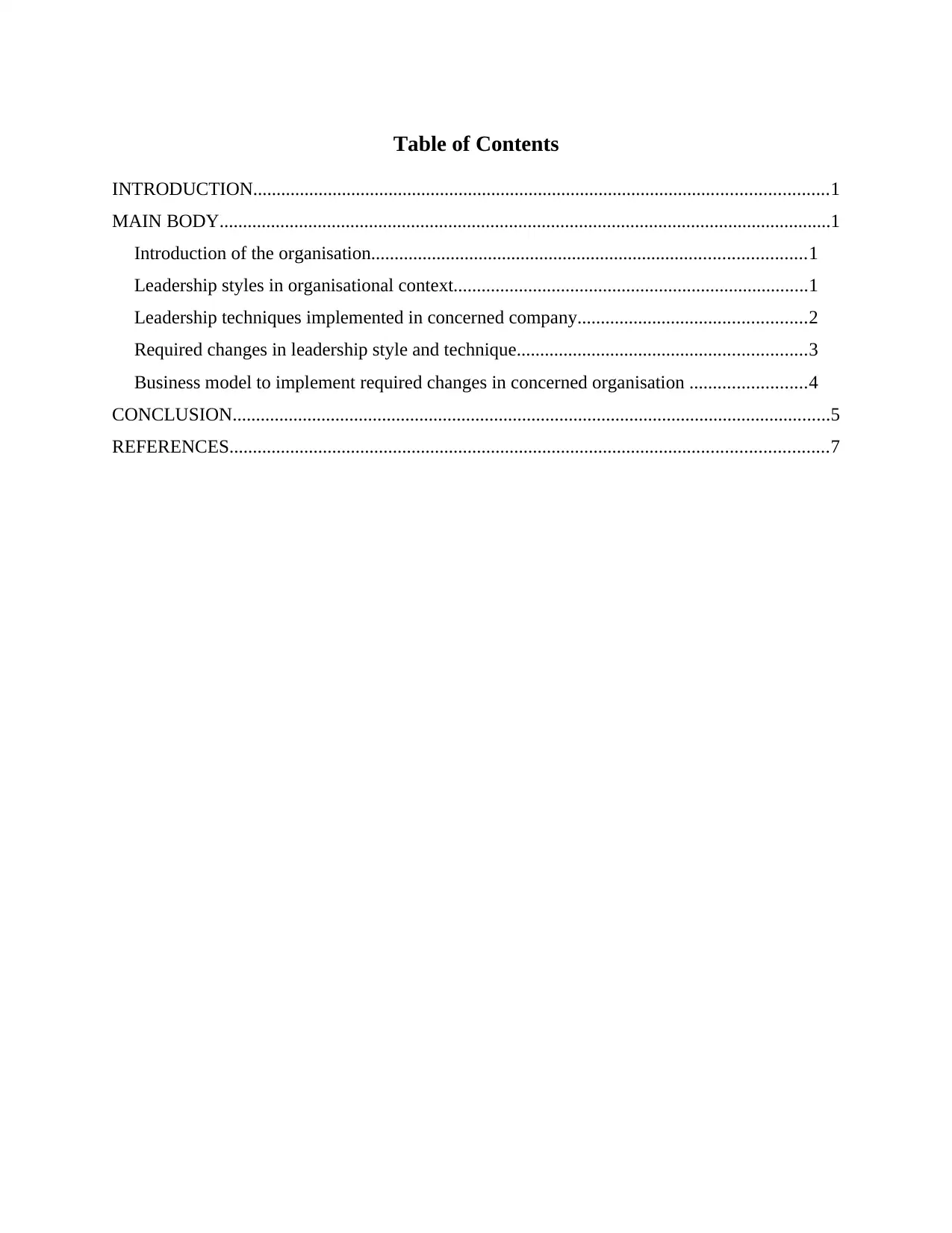
Table of Contents
INTRODUCTION...........................................................................................................................1
MAIN BODY...................................................................................................................................1
Introduction of the organisation.............................................................................................1
Leadership styles in organisational context............................................................................1
Leadership techniques implemented in concerned company.................................................2
Required changes in leadership style and technique..............................................................3
Business model to implement required changes in concerned organisation .........................4
CONCLUSION................................................................................................................................5
REFERENCES................................................................................................................................7
INTRODUCTION...........................................................................................................................1
MAIN BODY...................................................................................................................................1
Introduction of the organisation.............................................................................................1
Leadership styles in organisational context............................................................................1
Leadership techniques implemented in concerned company.................................................2
Required changes in leadership style and technique..............................................................3
Business model to implement required changes in concerned organisation .........................4
CONCLUSION................................................................................................................................5
REFERENCES................................................................................................................................7
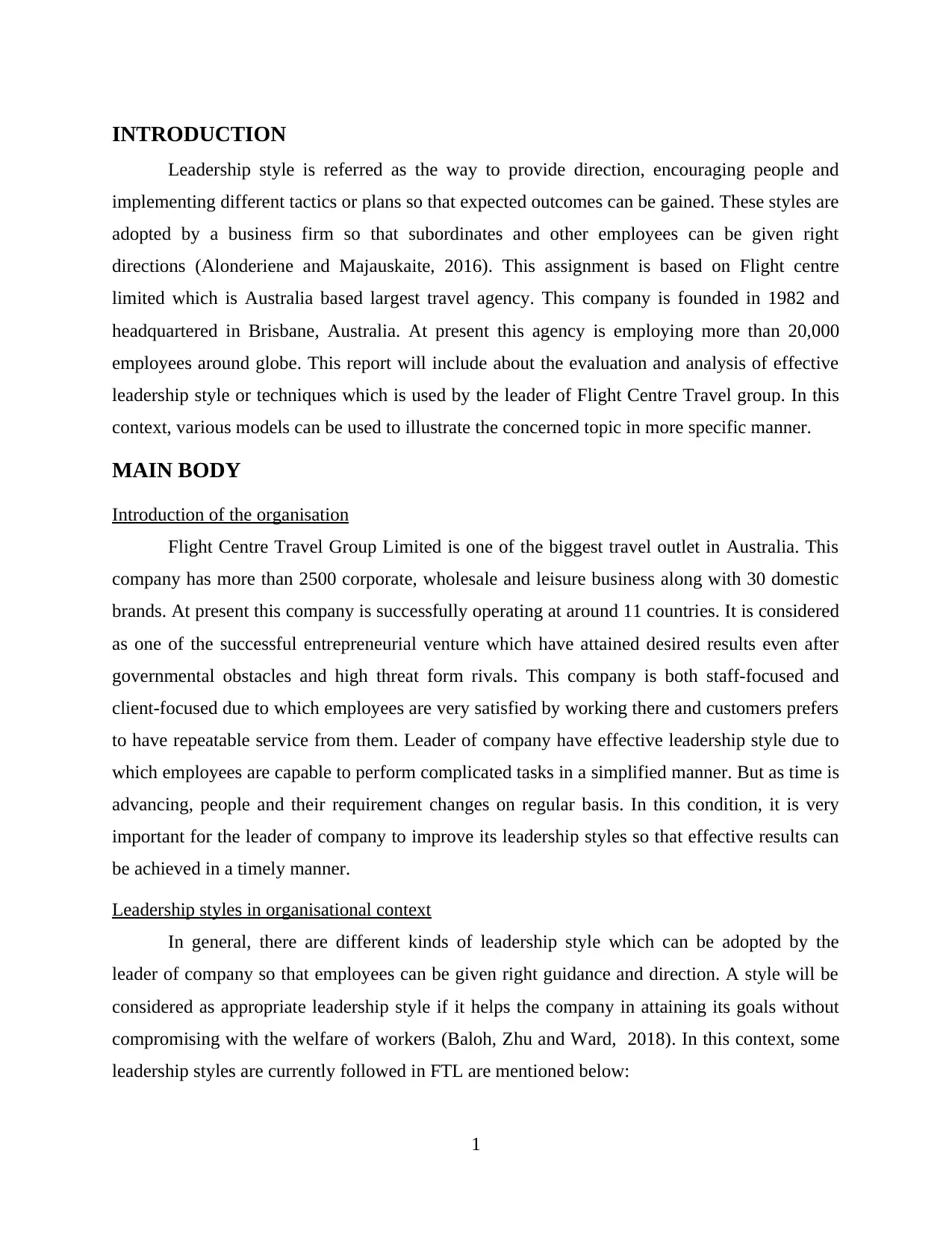
INTRODUCTION
Leadership style is referred as the way to provide direction, encouraging people and
implementing different tactics or plans so that expected outcomes can be gained. These styles are
adopted by a business firm so that subordinates and other employees can be given right
directions (Alonderiene and Majauskaite, 2016). This assignment is based on Flight centre
limited which is Australia based largest travel agency. This company is founded in 1982 and
headquartered in Brisbane, Australia. At present this agency is employing more than 20,000
employees around globe. This report will include about the evaluation and analysis of effective
leadership style or techniques which is used by the leader of Flight Centre Travel group. In this
context, various models can be used to illustrate the concerned topic in more specific manner.
MAIN BODY
Introduction of the organisation
Flight Centre Travel Group Limited is one of the biggest travel outlet in Australia. This
company has more than 2500 corporate, wholesale and leisure business along with 30 domestic
brands. At present this company is successfully operating at around 11 countries. It is considered
as one of the successful entrepreneurial venture which have attained desired results even after
governmental obstacles and high threat form rivals. This company is both staff-focused and
client-focused due to which employees are very satisfied by working there and customers prefers
to have repeatable service from them. Leader of company have effective leadership style due to
which employees are capable to perform complicated tasks in a simplified manner. But as time is
advancing, people and their requirement changes on regular basis. In this condition, it is very
important for the leader of company to improve its leadership styles so that effective results can
be achieved in a timely manner.
Leadership styles in organisational context
In general, there are different kinds of leadership style which can be adopted by the
leader of company so that employees can be given right guidance and direction. A style will be
considered as appropriate leadership style if it helps the company in attaining its goals without
compromising with the welfare of workers (Baloh, Zhu and Ward, 2018). In this context, some
leadership styles are currently followed in FTL are mentioned below:
1
Leadership style is referred as the way to provide direction, encouraging people and
implementing different tactics or plans so that expected outcomes can be gained. These styles are
adopted by a business firm so that subordinates and other employees can be given right
directions (Alonderiene and Majauskaite, 2016). This assignment is based on Flight centre
limited which is Australia based largest travel agency. This company is founded in 1982 and
headquartered in Brisbane, Australia. At present this agency is employing more than 20,000
employees around globe. This report will include about the evaluation and analysis of effective
leadership style or techniques which is used by the leader of Flight Centre Travel group. In this
context, various models can be used to illustrate the concerned topic in more specific manner.
MAIN BODY
Introduction of the organisation
Flight Centre Travel Group Limited is one of the biggest travel outlet in Australia. This
company has more than 2500 corporate, wholesale and leisure business along with 30 domestic
brands. At present this company is successfully operating at around 11 countries. It is considered
as one of the successful entrepreneurial venture which have attained desired results even after
governmental obstacles and high threat form rivals. This company is both staff-focused and
client-focused due to which employees are very satisfied by working there and customers prefers
to have repeatable service from them. Leader of company have effective leadership style due to
which employees are capable to perform complicated tasks in a simplified manner. But as time is
advancing, people and their requirement changes on regular basis. In this condition, it is very
important for the leader of company to improve its leadership styles so that effective results can
be achieved in a timely manner.
Leadership styles in organisational context
In general, there are different kinds of leadership style which can be adopted by the
leader of company so that employees can be given right guidance and direction. A style will be
considered as appropriate leadership style if it helps the company in attaining its goals without
compromising with the welfare of workers (Baloh, Zhu and Ward, 2018). In this context, some
leadership styles are currently followed in FTL are mentioned below:
1
⊘ This is a preview!⊘
Do you want full access?
Subscribe today to unlock all pages.

Trusted by 1+ million students worldwide
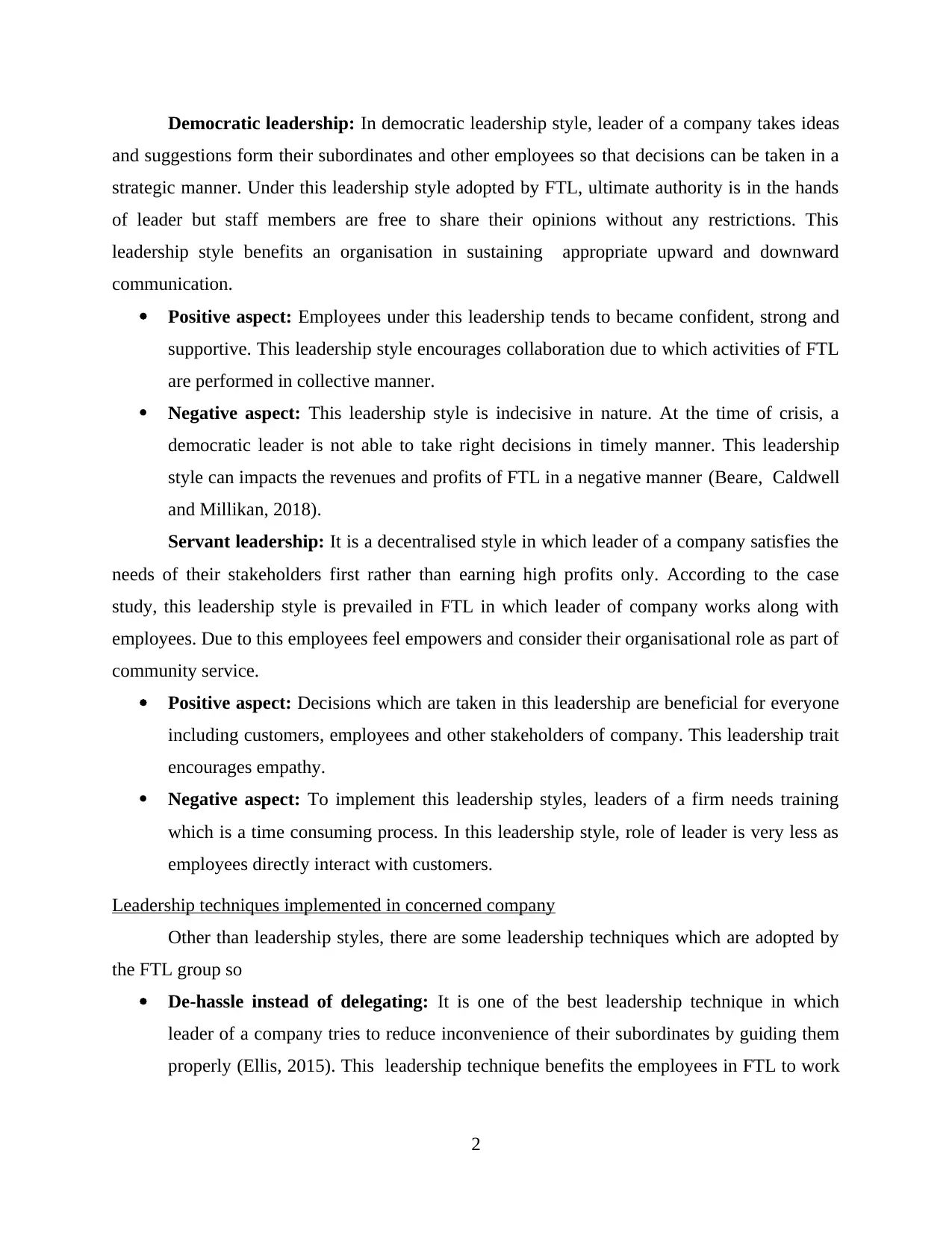
Democratic leadership: In democratic leadership style, leader of a company takes ideas
and suggestions form their subordinates and other employees so that decisions can be taken in a
strategic manner. Under this leadership style adopted by FTL, ultimate authority is in the hands
of leader but staff members are free to share their opinions without any restrictions. This
leadership style benefits an organisation in sustaining appropriate upward and downward
communication.
Positive aspect: Employees under this leadership tends to became confident, strong and
supportive. This leadership style encourages collaboration due to which activities of FTL
are performed in collective manner.
Negative aspect: This leadership style is indecisive in nature. At the time of crisis, a
democratic leader is not able to take right decisions in timely manner. This leadership
style can impacts the revenues and profits of FTL in a negative manner (Beare, Caldwell
and Millikan, 2018).
Servant leadership: It is a decentralised style in which leader of a company satisfies the
needs of their stakeholders first rather than earning high profits only. According to the case
study, this leadership style is prevailed in FTL in which leader of company works along with
employees. Due to this employees feel empowers and consider their organisational role as part of
community service.
Positive aspect: Decisions which are taken in this leadership are beneficial for everyone
including customers, employees and other stakeholders of company. This leadership trait
encourages empathy.
Negative aspect: To implement this leadership styles, leaders of a firm needs training
which is a time consuming process. In this leadership style, role of leader is very less as
employees directly interact with customers.
Leadership techniques implemented in concerned company
Other than leadership styles, there are some leadership techniques which are adopted by
the FTL group so
De-hassle instead of delegating: It is one of the best leadership technique in which
leader of a company tries to reduce inconvenience of their subordinates by guiding them
properly (Ellis, 2015). This leadership technique benefits the employees in FTL to work
2
and suggestions form their subordinates and other employees so that decisions can be taken in a
strategic manner. Under this leadership style adopted by FTL, ultimate authority is in the hands
of leader but staff members are free to share their opinions without any restrictions. This
leadership style benefits an organisation in sustaining appropriate upward and downward
communication.
Positive aspect: Employees under this leadership tends to became confident, strong and
supportive. This leadership style encourages collaboration due to which activities of FTL
are performed in collective manner.
Negative aspect: This leadership style is indecisive in nature. At the time of crisis, a
democratic leader is not able to take right decisions in timely manner. This leadership
style can impacts the revenues and profits of FTL in a negative manner (Beare, Caldwell
and Millikan, 2018).
Servant leadership: It is a decentralised style in which leader of a company satisfies the
needs of their stakeholders first rather than earning high profits only. According to the case
study, this leadership style is prevailed in FTL in which leader of company works along with
employees. Due to this employees feel empowers and consider their organisational role as part of
community service.
Positive aspect: Decisions which are taken in this leadership are beneficial for everyone
including customers, employees and other stakeholders of company. This leadership trait
encourages empathy.
Negative aspect: To implement this leadership styles, leaders of a firm needs training
which is a time consuming process. In this leadership style, role of leader is very less as
employees directly interact with customers.
Leadership techniques implemented in concerned company
Other than leadership styles, there are some leadership techniques which are adopted by
the FTL group so
De-hassle instead of delegating: It is one of the best leadership technique in which
leader of a company tries to reduce inconvenience of their subordinates by guiding them
properly (Ellis, 2015). This leadership technique benefits the employees in FTL to work
2
Paraphrase This Document
Need a fresh take? Get an instant paraphrase of this document with our AI Paraphraser
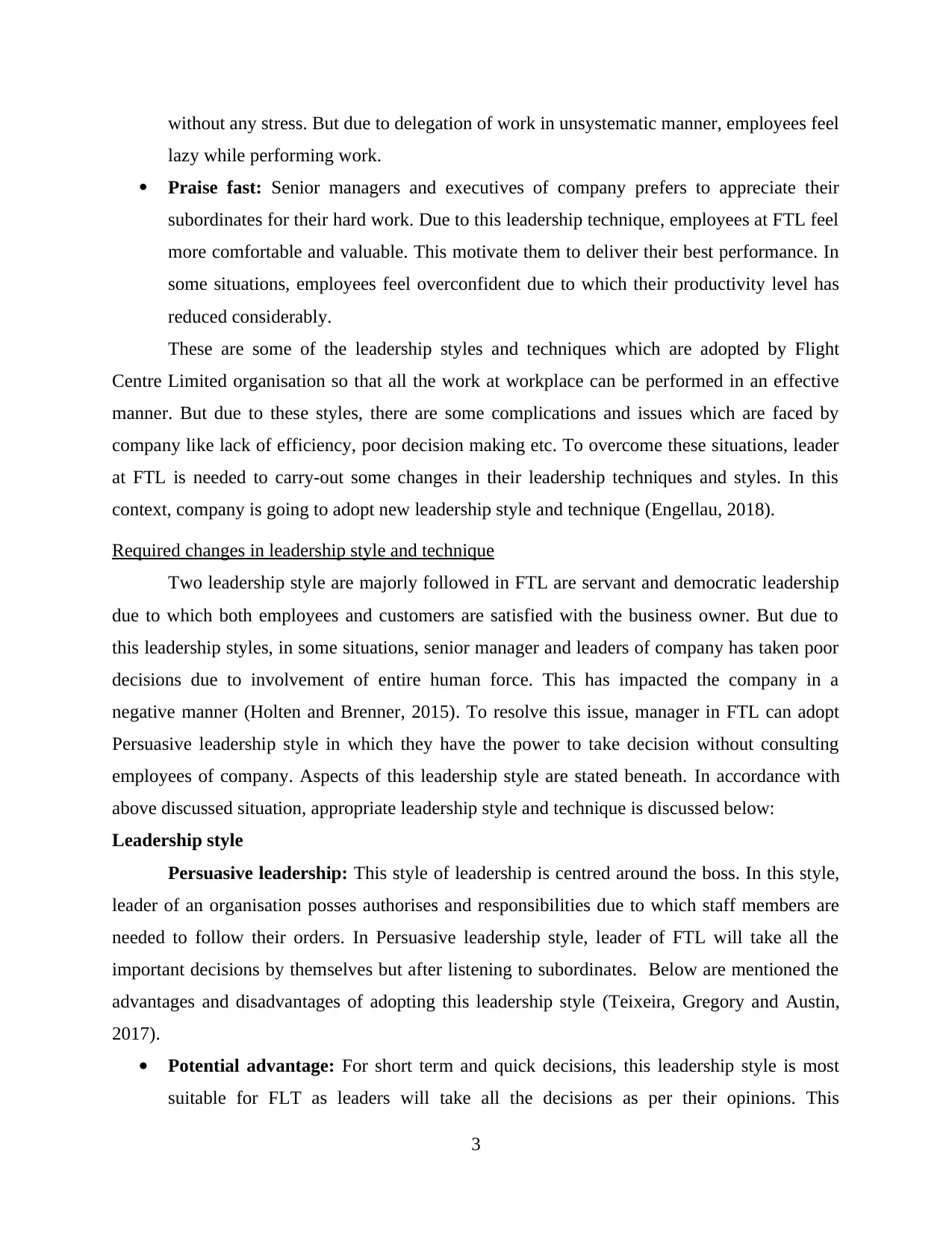
without any stress. But due to delegation of work in unsystematic manner, employees feel
lazy while performing work.
Praise fast: Senior managers and executives of company prefers to appreciate their
subordinates for their hard work. Due to this leadership technique, employees at FTL feel
more comfortable and valuable. This motivate them to deliver their best performance. In
some situations, employees feel overconfident due to which their productivity level has
reduced considerably.
These are some of the leadership styles and techniques which are adopted by Flight
Centre Limited organisation so that all the work at workplace can be performed in an effective
manner. But due to these styles, there are some complications and issues which are faced by
company like lack of efficiency, poor decision making etc. To overcome these situations, leader
at FTL is needed to carry-out some changes in their leadership techniques and styles. In this
context, company is going to adopt new leadership style and technique (Engellau, 2018).
Required changes in leadership style and technique
Two leadership style are majorly followed in FTL are servant and democratic leadership
due to which both employees and customers are satisfied with the business owner. But due to
this leadership styles, in some situations, senior manager and leaders of company has taken poor
decisions due to involvement of entire human force. This has impacted the company in a
negative manner (Holten and Brenner, 2015). To resolve this issue, manager in FTL can adopt
Persuasive leadership style in which they have the power to take decision without consulting
employees of company. Aspects of this leadership style are stated beneath. In accordance with
above discussed situation, appropriate leadership style and technique is discussed below:
Leadership style
Persuasive leadership: This style of leadership is centred around the boss. In this style,
leader of an organisation posses authorises and responsibilities due to which staff members are
needed to follow their orders. In Persuasive leadership style, leader of FTL will take all the
important decisions by themselves but after listening to subordinates. Below are mentioned the
advantages and disadvantages of adopting this leadership style (Teixeira, Gregory and Austin,
2017).
Potential advantage: For short term and quick decisions, this leadership style is most
suitable for FLT as leaders will take all the decisions as per their opinions. This
3
lazy while performing work.
Praise fast: Senior managers and executives of company prefers to appreciate their
subordinates for their hard work. Due to this leadership technique, employees at FTL feel
more comfortable and valuable. This motivate them to deliver their best performance. In
some situations, employees feel overconfident due to which their productivity level has
reduced considerably.
These are some of the leadership styles and techniques which are adopted by Flight
Centre Limited organisation so that all the work at workplace can be performed in an effective
manner. But due to these styles, there are some complications and issues which are faced by
company like lack of efficiency, poor decision making etc. To overcome these situations, leader
at FTL is needed to carry-out some changes in their leadership techniques and styles. In this
context, company is going to adopt new leadership style and technique (Engellau, 2018).
Required changes in leadership style and technique
Two leadership style are majorly followed in FTL are servant and democratic leadership
due to which both employees and customers are satisfied with the business owner. But due to
this leadership styles, in some situations, senior manager and leaders of company has taken poor
decisions due to involvement of entire human force. This has impacted the company in a
negative manner (Holten and Brenner, 2015). To resolve this issue, manager in FTL can adopt
Persuasive leadership style in which they have the power to take decision without consulting
employees of company. Aspects of this leadership style are stated beneath. In accordance with
above discussed situation, appropriate leadership style and technique is discussed below:
Leadership style
Persuasive leadership: This style of leadership is centred around the boss. In this style,
leader of an organisation posses authorises and responsibilities due to which staff members are
needed to follow their orders. In Persuasive leadership style, leader of FTL will take all the
important decisions by themselves but after listening to subordinates. Below are mentioned the
advantages and disadvantages of adopting this leadership style (Teixeira, Gregory and Austin,
2017).
Potential advantage: For short term and quick decisions, this leadership style is most
suitable for FLT as leaders will take all the decisions as per their opinions. This
3
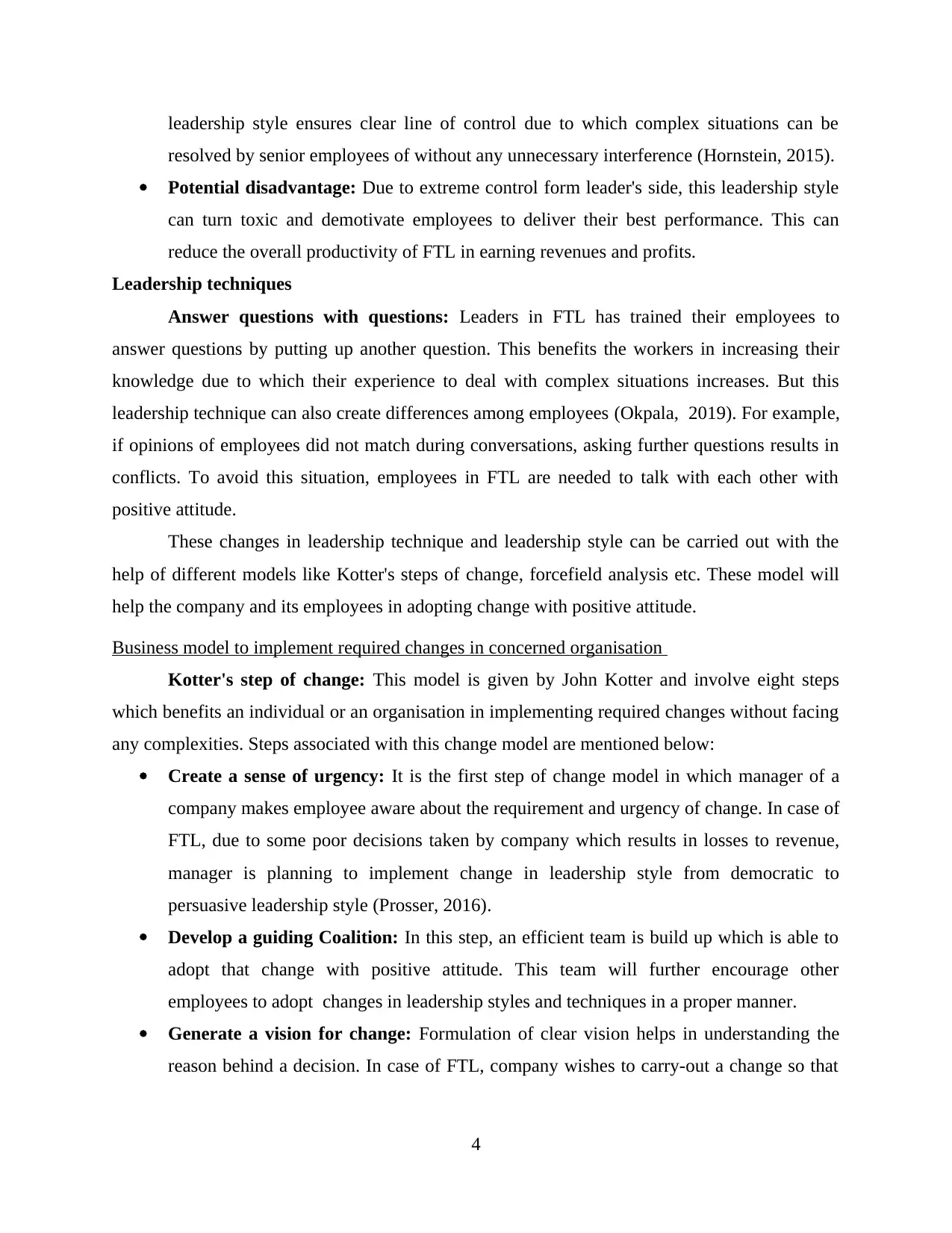
leadership style ensures clear line of control due to which complex situations can be
resolved by senior employees of without any unnecessary interference (Hornstein, 2015).
Potential disadvantage: Due to extreme control form leader's side, this leadership style
can turn toxic and demotivate employees to deliver their best performance. This can
reduce the overall productivity of FTL in earning revenues and profits.
Leadership techniques
Answer questions with questions: Leaders in FTL has trained their employees to
answer questions by putting up another question. This benefits the workers in increasing their
knowledge due to which their experience to deal with complex situations increases. But this
leadership technique can also create differences among employees (Okpala, 2019). For example,
if opinions of employees did not match during conversations, asking further questions results in
conflicts. To avoid this situation, employees in FTL are needed to talk with each other with
positive attitude.
These changes in leadership technique and leadership style can be carried out with the
help of different models like Kotter's steps of change, forcefield analysis etc. These model will
help the company and its employees in adopting change with positive attitude.
Business model to implement required changes in concerned organisation
Kotter's step of change: This model is given by John Kotter and involve eight steps
which benefits an individual or an organisation in implementing required changes without facing
any complexities. Steps associated with this change model are mentioned below:
Create a sense of urgency: It is the first step of change model in which manager of a
company makes employee aware about the requirement and urgency of change. In case of
FTL, due to some poor decisions taken by company which results in losses to revenue,
manager is planning to implement change in leadership style from democratic to
persuasive leadership style (Prosser, 2016).
Develop a guiding Coalition: In this step, an efficient team is build up which is able to
adopt that change with positive attitude. This team will further encourage other
employees to adopt changes in leadership styles and techniques in a proper manner.
Generate a vision for change: Formulation of clear vision helps in understanding the
reason behind a decision. In case of FTL, company wishes to carry-out a change so that
4
resolved by senior employees of without any unnecessary interference (Hornstein, 2015).
Potential disadvantage: Due to extreme control form leader's side, this leadership style
can turn toxic and demotivate employees to deliver their best performance. This can
reduce the overall productivity of FTL in earning revenues and profits.
Leadership techniques
Answer questions with questions: Leaders in FTL has trained their employees to
answer questions by putting up another question. This benefits the workers in increasing their
knowledge due to which their experience to deal with complex situations increases. But this
leadership technique can also create differences among employees (Okpala, 2019). For example,
if opinions of employees did not match during conversations, asking further questions results in
conflicts. To avoid this situation, employees in FTL are needed to talk with each other with
positive attitude.
These changes in leadership technique and leadership style can be carried out with the
help of different models like Kotter's steps of change, forcefield analysis etc. These model will
help the company and its employees in adopting change with positive attitude.
Business model to implement required changes in concerned organisation
Kotter's step of change: This model is given by John Kotter and involve eight steps
which benefits an individual or an organisation in implementing required changes without facing
any complexities. Steps associated with this change model are mentioned below:
Create a sense of urgency: It is the first step of change model in which manager of a
company makes employee aware about the requirement and urgency of change. In case of
FTL, due to some poor decisions taken by company which results in losses to revenue,
manager is planning to implement change in leadership style from democratic to
persuasive leadership style (Prosser, 2016).
Develop a guiding Coalition: In this step, an efficient team is build up which is able to
adopt that change with positive attitude. This team will further encourage other
employees to adopt changes in leadership styles and techniques in a proper manner.
Generate a vision for change: Formulation of clear vision helps in understanding the
reason behind a decision. In case of FTL, company wishes to carry-out a change so that
4
⊘ This is a preview!⊘
Do you want full access?
Subscribe today to unlock all pages.

Trusted by 1+ million students worldwide
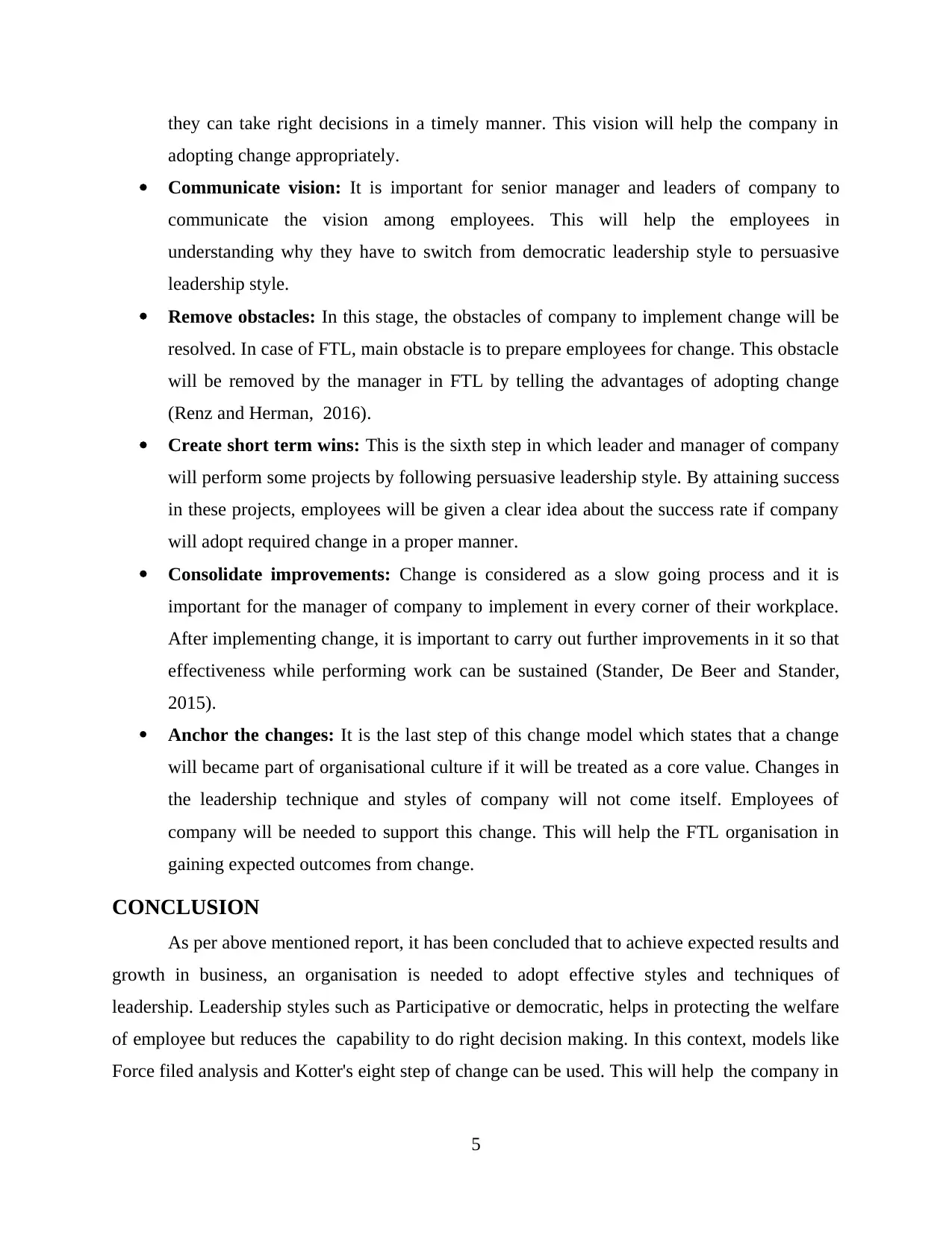
they can take right decisions in a timely manner. This vision will help the company in
adopting change appropriately.
Communicate vision: It is important for senior manager and leaders of company to
communicate the vision among employees. This will help the employees in
understanding why they have to switch from democratic leadership style to persuasive
leadership style.
Remove obstacles: In this stage, the obstacles of company to implement change will be
resolved. In case of FTL, main obstacle is to prepare employees for change. This obstacle
will be removed by the manager in FTL by telling the advantages of adopting change
(Renz and Herman, 2016).
Create short term wins: This is the sixth step in which leader and manager of company
will perform some projects by following persuasive leadership style. By attaining success
in these projects, employees will be given a clear idea about the success rate if company
will adopt required change in a proper manner.
Consolidate improvements: Change is considered as a slow going process and it is
important for the manager of company to implement in every corner of their workplace.
After implementing change, it is important to carry out further improvements in it so that
effectiveness while performing work can be sustained (Stander, De Beer and Stander,
2015).
Anchor the changes: It is the last step of this change model which states that a change
will became part of organisational culture if it will be treated as a core value. Changes in
the leadership technique and styles of company will not come itself. Employees of
company will be needed to support this change. This will help the FTL organisation in
gaining expected outcomes from change.
CONCLUSION
As per above mentioned report, it has been concluded that to achieve expected results and
growth in business, an organisation is needed to adopt effective styles and techniques of
leadership. Leadership styles such as Participative or democratic, helps in protecting the welfare
of employee but reduces the capability to do right decision making. In this context, models like
Force filed analysis and Kotter's eight step of change can be used. This will help the company in
5
adopting change appropriately.
Communicate vision: It is important for senior manager and leaders of company to
communicate the vision among employees. This will help the employees in
understanding why they have to switch from democratic leadership style to persuasive
leadership style.
Remove obstacles: In this stage, the obstacles of company to implement change will be
resolved. In case of FTL, main obstacle is to prepare employees for change. This obstacle
will be removed by the manager in FTL by telling the advantages of adopting change
(Renz and Herman, 2016).
Create short term wins: This is the sixth step in which leader and manager of company
will perform some projects by following persuasive leadership style. By attaining success
in these projects, employees will be given a clear idea about the success rate if company
will adopt required change in a proper manner.
Consolidate improvements: Change is considered as a slow going process and it is
important for the manager of company to implement in every corner of their workplace.
After implementing change, it is important to carry out further improvements in it so that
effectiveness while performing work can be sustained (Stander, De Beer and Stander,
2015).
Anchor the changes: It is the last step of this change model which states that a change
will became part of organisational culture if it will be treated as a core value. Changes in
the leadership technique and styles of company will not come itself. Employees of
company will be needed to support this change. This will help the FTL organisation in
gaining expected outcomes from change.
CONCLUSION
As per above mentioned report, it has been concluded that to achieve expected results and
growth in business, an organisation is needed to adopt effective styles and techniques of
leadership. Leadership styles such as Participative or democratic, helps in protecting the welfare
of employee but reduces the capability to do right decision making. In this context, models like
Force filed analysis and Kotter's eight step of change can be used. This will help the company in
5
Paraphrase This Document
Need a fresh take? Get an instant paraphrase of this document with our AI Paraphraser
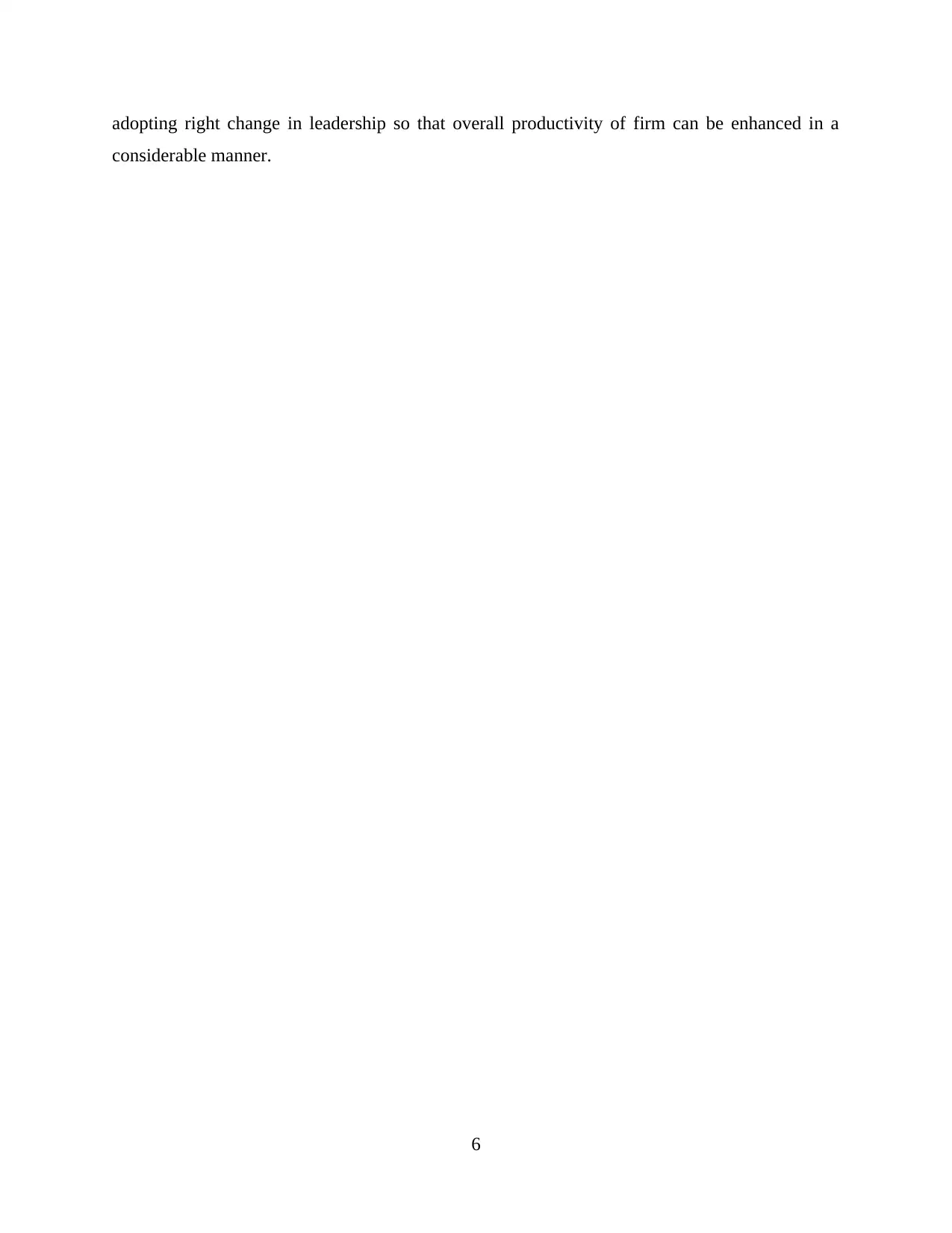
adopting right change in leadership so that overall productivity of firm can be enhanced in a
considerable manner.
6
considerable manner.
6
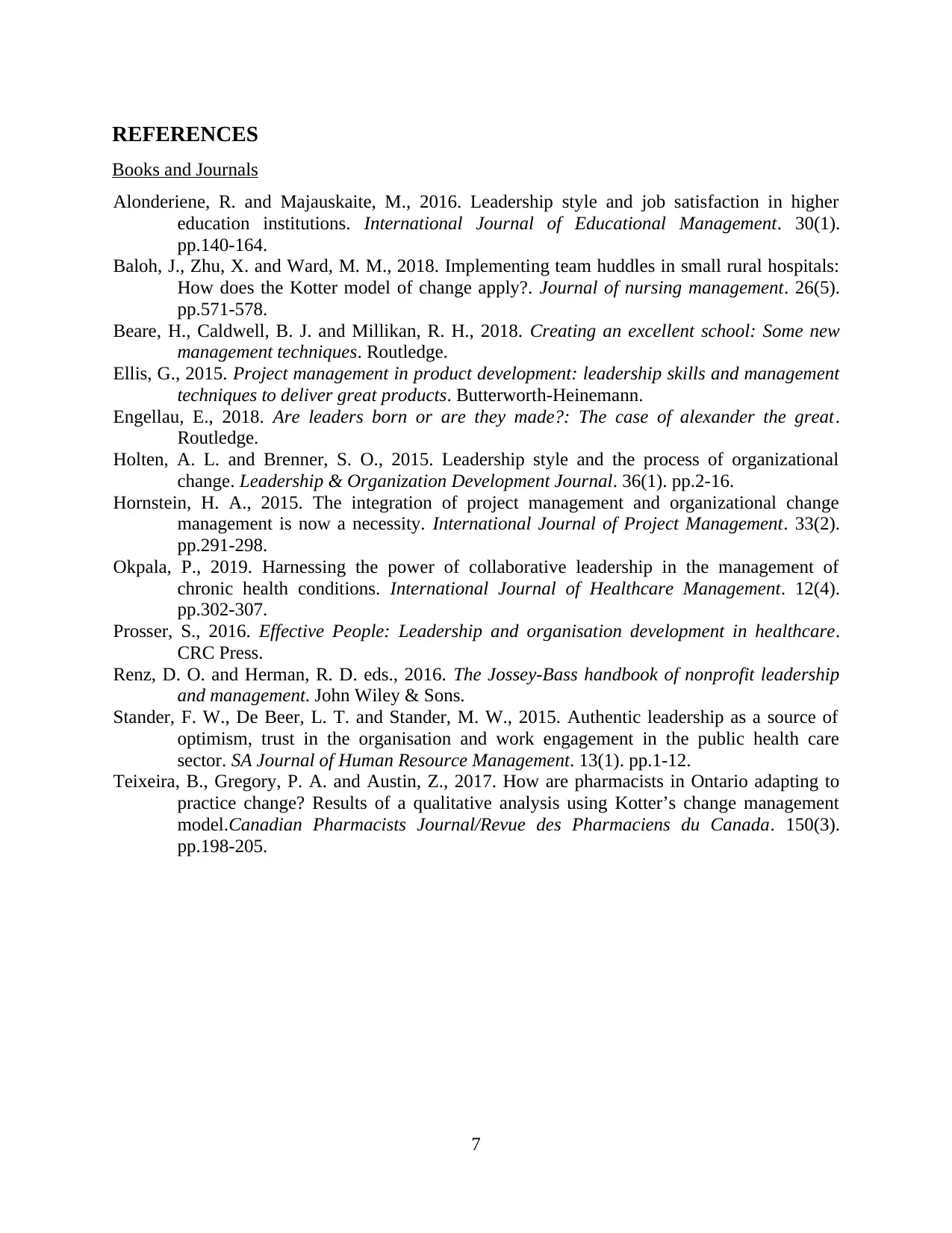
REFERENCES
Books and Journals
Alonderiene, R. and Majauskaite, M., 2016. Leadership style and job satisfaction in higher
education institutions. International Journal of Educational Management. 30(1).
pp.140-164.
Baloh, J., Zhu, X. and Ward, M. M., 2018. Implementing team huddles in small rural hospitals:
How does the Kotter model of change apply?. Journal of nursing management. 26(5).
pp.571-578.
Beare, H., Caldwell, B. J. and Millikan, R. H., 2018. Creating an excellent school: Some new
management techniques. Routledge.
Ellis, G., 2015. Project management in product development: leadership skills and management
techniques to deliver great products. Butterworth-Heinemann.
Engellau, E., 2018. Are leaders born or are they made?: The case of alexander the great.
Routledge.
Holten, A. L. and Brenner, S. O., 2015. Leadership style and the process of organizational
change. Leadership & Organization Development Journal. 36(1). pp.2-16.
Hornstein, H. A., 2015. The integration of project management and organizational change
management is now a necessity. International Journal of Project Management. 33(2).
pp.291-298.
Okpala, P., 2019. Harnessing the power of collaborative leadership in the management of
chronic health conditions. International Journal of Healthcare Management. 12(4).
pp.302-307.
Prosser, S., 2016. Effective People: Leadership and organisation development in healthcare.
CRC Press.
Renz, D. O. and Herman, R. D. eds., 2016. The Jossey-Bass handbook of nonprofit leadership
and management. John Wiley & Sons.
Stander, F. W., De Beer, L. T. and Stander, M. W., 2015. Authentic leadership as a source of
optimism, trust in the organisation and work engagement in the public health care
sector. SA Journal of Human Resource Management. 13(1). pp.1-12.
Teixeira, B., Gregory, P. A. and Austin, Z., 2017. How are pharmacists in Ontario adapting to
practice change? Results of a qualitative analysis using Kotter’s change management
model.Canadian Pharmacists Journal/Revue des Pharmaciens du Canada. 150(3).
pp.198-205.
7
Books and Journals
Alonderiene, R. and Majauskaite, M., 2016. Leadership style and job satisfaction in higher
education institutions. International Journal of Educational Management. 30(1).
pp.140-164.
Baloh, J., Zhu, X. and Ward, M. M., 2018. Implementing team huddles in small rural hospitals:
How does the Kotter model of change apply?. Journal of nursing management. 26(5).
pp.571-578.
Beare, H., Caldwell, B. J. and Millikan, R. H., 2018. Creating an excellent school: Some new
management techniques. Routledge.
Ellis, G., 2015. Project management in product development: leadership skills and management
techniques to deliver great products. Butterworth-Heinemann.
Engellau, E., 2018. Are leaders born or are they made?: The case of alexander the great.
Routledge.
Holten, A. L. and Brenner, S. O., 2015. Leadership style and the process of organizational
change. Leadership & Organization Development Journal. 36(1). pp.2-16.
Hornstein, H. A., 2015. The integration of project management and organizational change
management is now a necessity. International Journal of Project Management. 33(2).
pp.291-298.
Okpala, P., 2019. Harnessing the power of collaborative leadership in the management of
chronic health conditions. International Journal of Healthcare Management. 12(4).
pp.302-307.
Prosser, S., 2016. Effective People: Leadership and organisation development in healthcare.
CRC Press.
Renz, D. O. and Herman, R. D. eds., 2016. The Jossey-Bass handbook of nonprofit leadership
and management. John Wiley & Sons.
Stander, F. W., De Beer, L. T. and Stander, M. W., 2015. Authentic leadership as a source of
optimism, trust in the organisation and work engagement in the public health care
sector. SA Journal of Human Resource Management. 13(1). pp.1-12.
Teixeira, B., Gregory, P. A. and Austin, Z., 2017. How are pharmacists in Ontario adapting to
practice change? Results of a qualitative analysis using Kotter’s change management
model.Canadian Pharmacists Journal/Revue des Pharmaciens du Canada. 150(3).
pp.198-205.
7
⊘ This is a preview!⊘
Do you want full access?
Subscribe today to unlock all pages.

Trusted by 1+ million students worldwide
1 out of 9
Related Documents
Your All-in-One AI-Powered Toolkit for Academic Success.
+13062052269
info@desklib.com
Available 24*7 on WhatsApp / Email
![[object Object]](/_next/static/media/star-bottom.7253800d.svg)
Unlock your academic potential
Copyright © 2020–2025 A2Z Services. All Rights Reserved. Developed and managed by ZUCOL.





